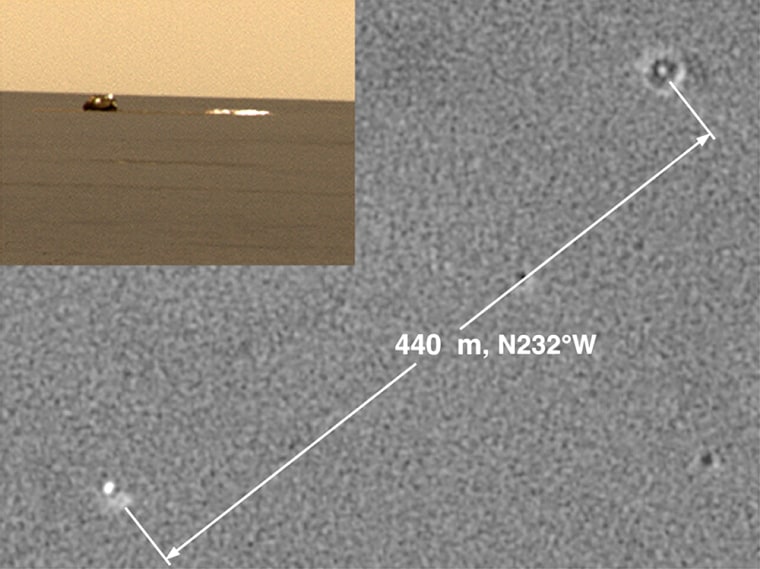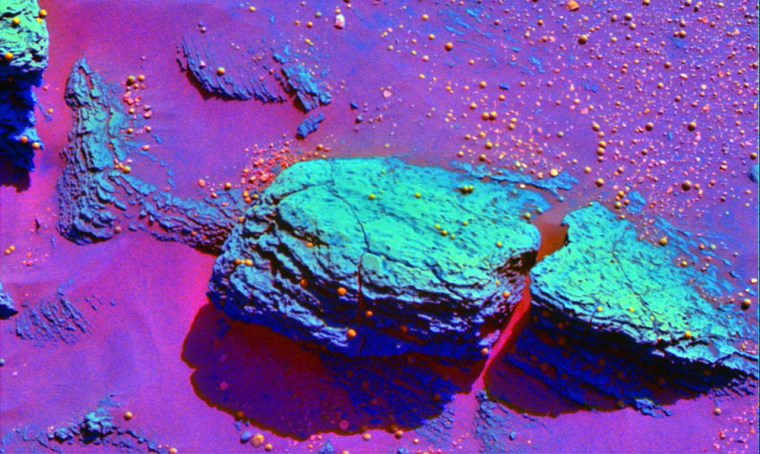NASA’s Opportunity rover peeked over the rim of the crater in which it landed and was able to see the clamshell holder and parachute it discarded just before hitting the surface of Mars, scientists said Monday.
A color photograph from Opportunity, released at NASA’s Jet Propulsion Laboratory, showed the two objects distinctly, on a largely featureless surface.
“There is the hardware that we’ve littered the surface with,” said Michael Malin, a member of the mission science team.
The rover was shielded by a clamshell-like device during its entry into the atmosphere of Mars.
The photograph, when combined with pictures taken from orbit, helped confirm exactly where Opportunity landed on Mars on Jan. 24. NASA planned for its orbiting Mars Global Surveyor satellite to begin looking for another Martian spacecraft, Britain’s ill-fated Beagle 2 lander, on Thursday.
NASA described the gray photograph shown Monday as an “approximate true-color image.” Mars’ iron-rich dust gives the planet its overall reddish color, but Opportunity landed in a relatively dust-free area.

Scientists likened Opportunity's landing to a hole-in-one by a golfer who cannot see the hole. Cushioned by airbags, the rover bounced and rolled across the Martian surface right into a 72-foot-wide (22-meter-wide) crater, where Opportunity has plenty of exposed bedrock in reach of its robotic geologic instruments.
Opportunity's first close-up images of the bedrock outcropping revealed fine-scale layering, with round beads of rock tucked within and scattered around the formation. Cornell University astronomer Steve Squyres, the mission's principal science investigator, compared the "spherules" to blueberries inside a muffin.
Scientists had three theories about the origin of the spherules, Squyres said. They could be:
- Droplets of molten rock, created during a volcanic eruption or a meteor impact, that hardened into spheres in midair.
- Concretions of minerals that accumulated when ground water percolated through layers of rock.
- Lapilli, or grains of volcanic ash that stuck together after an eruption.
Squyres said the lapilli explanation was the least likely of the three, since such beads are generally made of the same material they're embedded in. The Martian rock-berries, in contrast, appear to be made of material that's different from the bedrock layers.
"We think we should be able to test all of those" theories, Squyres said.
Over the next few days, Opportunity would roll along the length of the outcropping, now dubbed Opportunity Ledge. Along the way the rover would make a survey of the best spots for further study, Squyres said. Eventually, the rover will use its rock abrasion tool to grind away at the bedrock, then use its scientific instruments to determine the composition of the spherules as well as the surrounding rock matrix.
Just a few hours before Monday's news briefing, Opportunity's alpha proton X-ray spectrometer had completed an analysis of the bedrock's chemical composition, "and it has got a lot of sulfur in it," Squyres said. But he said it was too early to speculate on what that high sulfur content might mean.
Spirit moves on
Opportunity is just half of a two-rover, $820 million mission looking for geologic evidence that ancient Mars had liquid water long enough to allow for the development of life.
Opportunity's twin, the Spirit rover, is on the other side of the Red Planet, studying the rocks and soil of Gusev Crater. Over the weekend, Spirit's rock abrasion tool drilled a tenth of an inch (3 millimeters) into a pyramid-shaped basaltic rock named Adirondack and conducted a first-ever analysis of the rock's fresh interior.
All the evidence pointed toward Adirondack's volcanic origins — which meant the rock was unlikely to shed light on the liquid-water question. During its workday, Spirit moved on from Adirondack toward its next target, a stone called "White Boat."
Mobility software engineer Mark Maimone said the 21-foot (6.4-meter) drive was the "first test on Mars of the rover's autonomous navigation system." Engineers told Spirit where to drive, but the robotic rover decided on its own exactly how to get there.
Spirit had been stalled at Adirondack for more than two weeks due to a memory management glitch. Nevertheless, Maimone said Spirit's sprint briefly gave it the lead over Opportunity for total distance traveled, at 41 feet (12.5 meters). Opportunity's movement as of Monday put it back ahead by a nose, with total travel of 42.7 feet (13 meters), he said.
"So the race is on," Maimone said.
